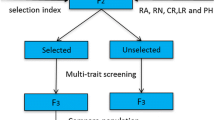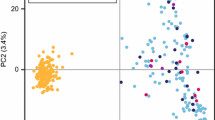Summary
The variation among the component lines of the KSML 3 (a multiline based on cultivar Kalyansona, spring bread wheat) was studied for agronomic characteristics. For days to earing and plant height the variation was small. This helped in imparting uniformity to the multiline. The lines had an improved tillering ability and had larger seeds. This partially explained the increased yield potential of the multiline as compared with Kalyansona.
All the lines were susceptible only to one or two races of the yellow and brown rust. In no case any race was virulent against all the lines. In the field all the lines were resistant to both rusts.
Similar content being viewed by others
References
Borlaug, N. E., 1958. The use of multilineal or composite varieties to control airborne epidemic diseases of self-pollinated crop plants. Proc. 1st Intern. Wheat Genet. Symp. Winnipeg, Canada, pp 12–27.
Gill, K. S., G. S. Nanda & G. Singh, 1978. Studies on multilines in wheat-A review. Proc. 5th Intern. Wheat Genet. Symp., New Delhi (India) (in press).
Robinson R. A., 1976. Plant pathosystems. Springer-Verlag, Berlin-Heidelberg-New York. 184 pp.
Stakman, E. C. & M. H. Levine, 1922. The determination of biologic forms of Puccinia graminis on Triticum spp. Minn. Agr. Exp. Sta. Tech. Bull. 8.
Author information
Authors and Affiliations
Rights and permissions
About this article
Cite this article
Gill, K.S., Nanda, G.S., Singh, G. et al. Studies on multilines in wheat (Triticum aestivum L.).12. Breeding of a multiline variety by convergence of breeding lines. Euphytica 29, 125–128 (1980). https://doi.org/10.1007/BF00037257
Received:
Issue Date:
DOI: https://doi.org/10.1007/BF00037257




